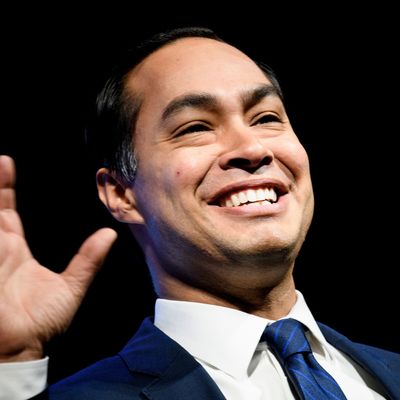
The vast 2020 Democratic presidential field has a lot of diversity. It includes three African-Americans (if you include Miramar, Florida, mayor Wayne Hassam, as you probably should), three Asian-Americans, six women, a Hindu, a Jew, and an openly gay married man.
But there’s only one representative of the country’s, and the Democratic Party’s, fastest-growing demographic group, Latinos. That would be former San Antonio mayor and HUD secretary Julián Castro.
Castro has an impressive résumé for a 44-year-old pol. But it’s easy to underestimate him as a presidential candidate. Some progressives don’t trust him because of his alleged coziness with Wall Street at HUD (which he tartly denied in an interview with my colleague Gabriel Debenedetti). He hasn’t raised a lot of money ($1.1 million in the first quarter of 2019, compared with $9.4 million for fellow Texan Beto O’Rourke). He’s nowhere in the polls so far (he’s currently ninth in the polling averages at RealClearPolitics, at 1.3 percent). And although he’s the second credible Latino candidate for president (after Bill Richardson in 2008), and is the grandchild of immigrants from Mexico, he’s not really fluent in Spanish.
Still, he has a position on the crucial immigration issue that should appeal to fellow Latinos, and actually represents a lot of second- or third-generation Latino-Americans who are shaky in Spanish. And if he can demonstrate some political viability very early in the nomination process, he has an enormous potential for a breakthrough soon thereafter, as Perry Bacon Jr. explains:
For Castro … the ideal scenario is that he is a viable candidate when the primaries start in February, so he can galvanize Latinos behind him in three key states in particular: California, Nevada and Texas. Nevada (where about 20 percent of Democratic primary voters are likely to be Latino) is currently scheduled to be the third state to vote. California and Texas, the two states with the largest Latino populations, hold their primaries along with several other states on Super Tuesday, on March 3, but both states allow early voting, so lots of voters in both states will cast ballots in February.
So he’s in a bit of a trap: He can’t mobilize Latino voters behind him unless he demonstrates viability, and he won’t look viable without strong Latino support. He has plenty of time to make a strong impression in debates and retail campaigning. And like those Democratic rivals who are boasting of their electability as ambassadors to Trump voters in the Heartland, Castro has his own electability argument, as Bacon notes:
When I asked Castro how he would present himself as “electable” to Democratic voters, he named six states that he felt he could flip: Michigan, Pennsylvania and Wisconsin, which Clinton barely lost in 2016, along with Arizona, Florida and Texas. Castro didn’t outright say this, but the implication was obvious: Arizona, Florida and Texas are the three states with the largest Latino electorates that did not vote for Democrats in 2016.
It’s not entirely clear how Julián Castro makes himself the Barack Obama of Latino Democrats, but until he fails, it would be foolish to count him out.
This post has been corrected to show that Castro is the grandchild of immigrants, not the child of immigrants as incorrectly stated originally.






























